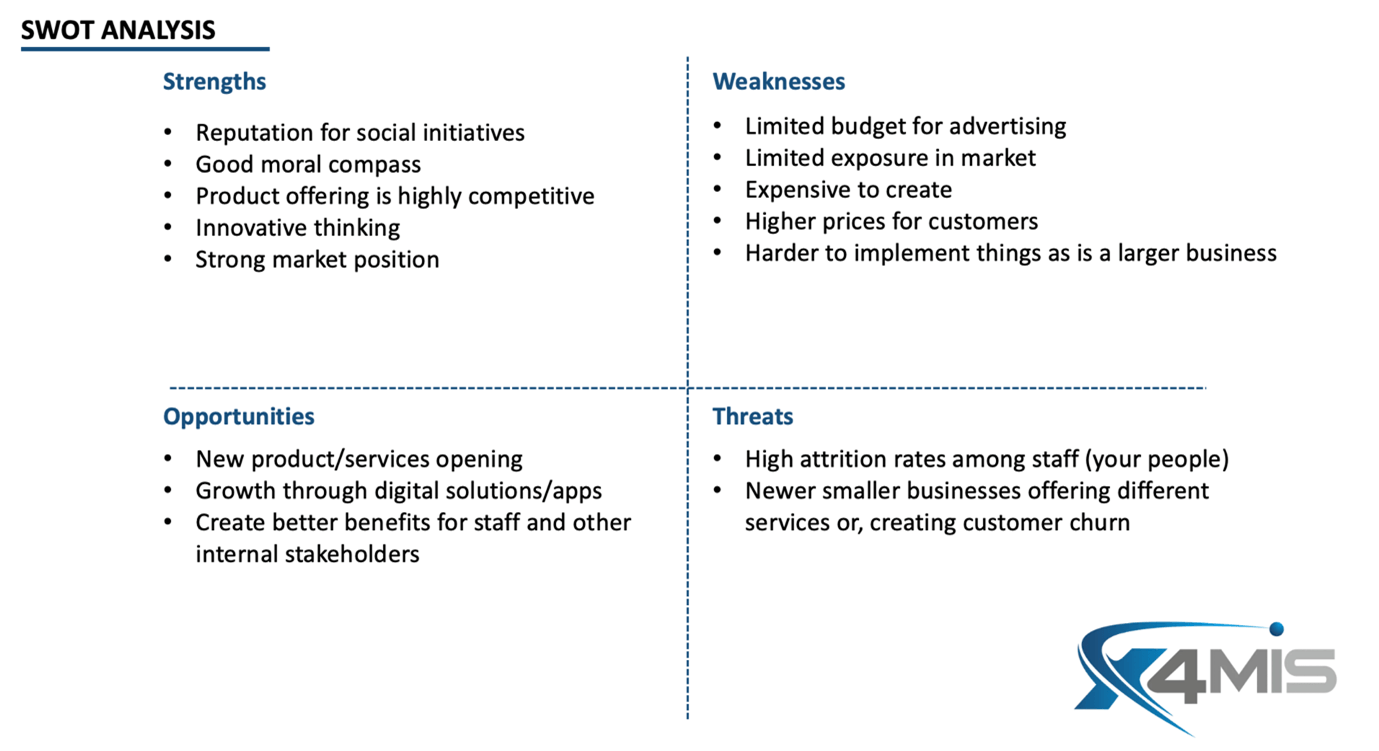SWOT Analysis
Strength, Weakness, Opportunity, and Threats (SWOT Analysis)
Written by Jack Ruddenklau
What is a SWOT analysis?
A SWOT analysis examines a business's strengths, weaknesses, opportunities, and threats. It is often used to analyse and assess business’s products, services, performance, competition or even consequences in the case of a change initiative. Opportunities and threats typically can be both internal and external. While strengths and weaknesses arise within the business as internal elements. The analysis is divided into a four-square grid.
Why use SWOT analysis?
Change is not an easy task, especially the larger organisations. SWOT helps leaders compare and understand the impact of change on the business as they prepare for the new way of working.
A SWOT analysis is often used to help captivate people within a business to acknowledge that change is needed. But it can go much further than this, as it can be used to recognise what is preventing a change initiative, already in progress, from reaching its goals (like the Forcefield Analysis). To ensure a transparent, impartial, and positive approach which avoids the fear of change, it is critical consulting with employees and key stakeholders in the completion of the SWOT analysis.
Prerequisites
You will need the change team and key stakeholders (identified in the Stakeholder Analysis) ready to complete the SWOT analysis, a change initiative could be in progress already, or you can use the template to identify a new initiative. It is important to ensure the SWOT is completed by people representing all the business areas for an unbiased opinion. The SWOT analysis can be completed to compliment or replace:
How to use the SWOT analysis?
- Identify and invite the change team and key stakeholders to a workshop to perform the analysis.
- Setup the template on a large projector or whiteboard.
- Brainstorm - its best to start with Strengths, then Weaknesses, followed by Opportunities and then Threats.
- Ask the questions below for each element of the SWOT.
- Make it easily understandable for all, so organise the answered parts in a single document.
- Finally, act on what the SWOT analysis found.
Questions for Strengths:
Strengths is the first element of the SWOT analysis. The element determines what strengths are within a business. By asking the questions below, you may be able to decide on some strengths to add into the template:
- Why does the business perform better than others within your industry?
- Why is your brand iconic to customers, and why do they like your products/services?
- What sells your services/products to customers, and why is your business unique to the competition?
- Is the business in a better position in terms of resources than other competitors?
The questions above give a great starting point for identifying Strengths within your business. The change team will be able to develop more as they start going through each element of the SWOT analysis.
Questions for Weaknesses:
The second element helps identifies your businesses weaknesses, here are a few questions to get you started:
- What are the negatives that your business faces?
- What could you do better for your customers or your internal stakeholders?
- What do you not have that your competitors do?
- What makes your customers leave your business?
- What are the biggest challenges your business face?
The Strengths and Weaknesses are often the easier ones to identify, as these tend to be internal elements. Opportunities and Threats are usually external, but sometimes these can be internal.
Questions for Opportunities
Use the following questions to help the change team identify Opportunities:
- What feedback to we receive the most? How could we develop this into an opportunity?
- What could we do to better our brand position?
- What ways could we improve our processes for our people?
- Can we design our customer experience strategy in a better way to enable higher customer proposition?
- Can we reallocate resources to create a better experience for all? Do we have a higher budget to leverage the best resources?
Questions for identifying Threats:
Coming up with Threats are typically easier to find than opportunities, you would of likely found threats by asking the questions about opportunities as the threat is there and coincides with opportunities.
- Is the regulatory environment changing?
- Are competitors launching new products to ‘steal’ customers from you?
- Why is our attrition rate high among your people? Could this be due to a bad culture.
- Is the pandemic causing uncertainty? How could this mean in terms of losing customers?
Often by identifying the Threats and Opportunities you identify an overlap. If an overlap is identified it is an opportunity to further develop your business, you can reduce the Threat and further harness the Opportunity.
Next steps
Once the SWOT analysis has been completed and the majority agree with the assessment elements, act on what the analysis has found.
Every analysis is different, so this article does not detail how to act on the analysis. Focus on. It’s about seeing the threats, opportunities and actions which can be improved or changed and then converting those into strengths for the change initiative.
The image below has examples of different elements which may be identified in the template you can use for the analysis.

Compose the Change
Browse by Categories

Free On-Line Change Management Methodology that enables individuals and organisations, especially those previously without access to effective change management programmes, to deliver more effective community and country programmes which improve prosperity and save lives.
QUICKLINKS
TRAINING LINKS
LATEST POSTS




